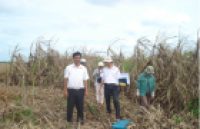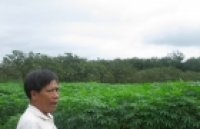| Exploring the areas of applicability of whole genome prediction methods for Asian rice (Oryza sativa L.) |
|
Whole-genome prediction is used to predict genetic value from genome-wide markers. The choice of method is important for successful prediction. We compared nine methods using empirical data for eight phenological and morphological traits of Asian rice cultivars (Oryza sativa L.) and data simulated from real marker genotype data. The methods were genomic BLUP (GBLUP), reproducing kernel Hilbert spaces regression (RKHS), Lasso, elastic net, random forest (RForest) |
|
Akio Onogi · Osamu Ideta · Yuto Inoshita · Kaworu Ebana · Takuma Yoshioka · Masanori Yamasaki · Hiroyoshi Iwata Theoretical and Applied Genetics, January 2015, Volume 128, Issue 1, pp 41-53 http://link.springer.com/journal/volumesAndIssues/122
AbstractKey message
Our simulation results clarify the areas of applicability of nine prediction methods and suggest the factors that affect their accuracy at predicting empirical traits. Abstract
Whole-genome prediction is used to predict genetic value from genome-wide markers. The choice of method is important for successful prediction. We compared nine methods using empirical data for eight phenological and morphological traits of Asian rice cultivars (Oryza sativa L.) and data simulated from real marker genotype data. The methods were genomic BLUP (GBLUP), reproducing kernel Hilbert spaces regression (RKHS), Lasso, elastic net, random forest (RForest), Bayesian lasso (Blasso), extended Bayesian lasso (EBlasso), weighted Bayesian shrinkage regression (wBSR), and the average of all methods (Ave). The objectives were to evaluate the predictive ability of these methods in a cultivar population, to characterize them by exploring the area of applicability of each method using simulation, and to investigate the causes of their different accuracies for empirical traits. GBLUP was the most accurate for one trait, RKHS and Ave for two, and RForest for three traits. In the simulation, Blasso, EBlasso, and Ave showed stable performance across the simulated scenarios, whereas the other methods, except wBSR, had specific areas of applicability; wBSR performed poorly in most scenarios. For each method, the accuracy ranking for the empirical traits was largely consistent with that in one of the simulated scenarios, suggesting that the simulation conditions reflected the factors that affected the method accuracy for the empirical results. This study will be useful for genomic prediction not only in Asian rice, but also in populations from other crops with relatively small training sets and strong linkage disequilibrium structures.
|
|
|
|
[ Tin tức liên quan ]___________________________________________________
|


 Curently online :
Curently online :
 Total visitors :
Total visitors :
(17).png)


